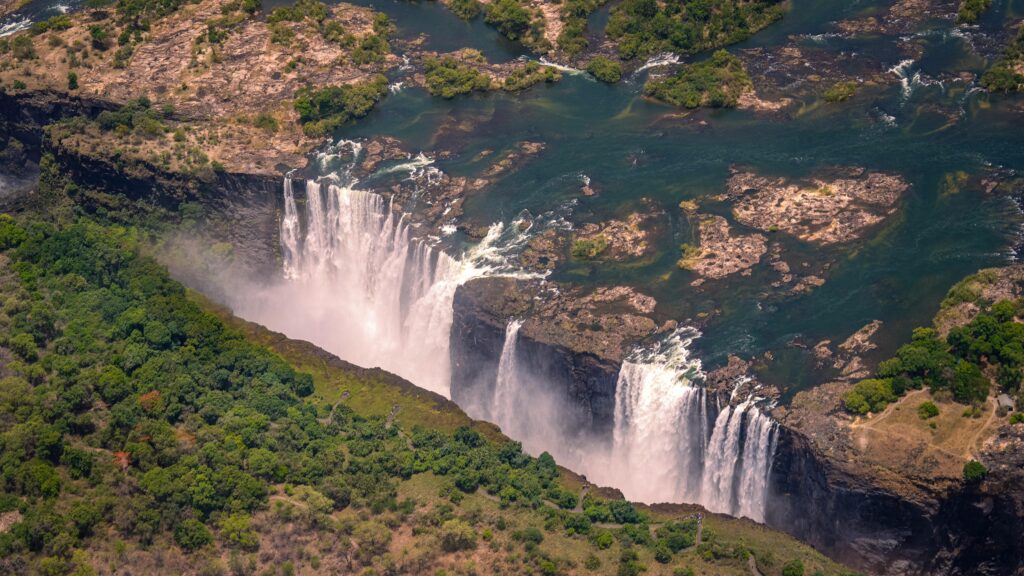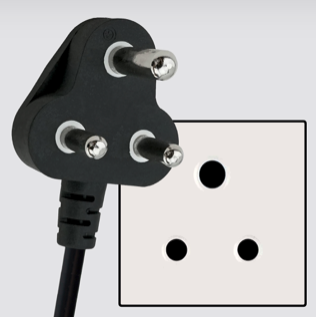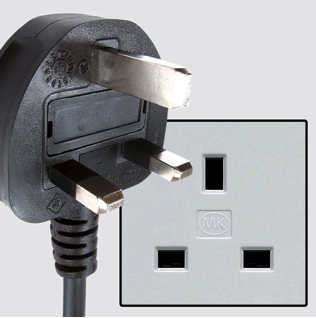Zimbabwe / Nyika yeZimbabwe / Ilizwe leZimbabwe – Let’s explore here
What’s it like in Zimbabwe?
Zimbabwe is a landlocked country in central Africa, very slightly larger than Norway or Japan. It mostly consists of a high central plateau with some hills and mountains to the east. The highest point is Mount Nyangani, in the east of the country, at 8,504 ft (2,592 m) above sea level. Victoria Falls, one of the world’s largest waterfalls, and the Zambezi river are located in the north west.
It has a long and troubled history, including a period with the second highest hyperinflation ever experienced in the world. It shares land borders with Zambia, Mozambique, South Africa, Botswana and Angola; it’s also just over 600 feet from Namibia!
The population of Zimbabwe is around 17 million people (2024), about 1½ million of whom live in the capital, Harare.

A bit about the history of Zimbabwe
Pre-Colonial Era
Zimbabwe, formerly known as Rhodesia, has a long history dating back to ancient times, with early civilisations such as the Kingdom of Zimbabwe. The Great Zimbabwe ruins, built between the 11th and 15th centuries, are a testament to the country’s advanced culture and were a central trading hub in southern Africa. Various ethnic groups, including the Shona, Ndebele and others, inhabited the region, establishing their own political and social structures.
Colonial Period
In the late 19th century, the British colonised the area, initially through the British South Africa Company (BSAC) under Cecil Rhodes. The region became known as Southern Rhodesia. White settlers, with the support of the colonial government, took control of most of the land, leading to the displacement of indigenous African populations. By the early 20th century, the country had become a self governing colony under British rule, with the white minority holding significant political power.
Struggle for Independence
In the 1960s, nationalist movements emerged, primarily led by Robert Mugabe’s Zimbabwe African National Union (ZANU) and Joshua Nkomo’s Zimbabwe African People’s Union (ZAPU). These groups fought against the oppressive colonial and white minority rule. The liberation war, also known as the Second Chimurenga, intensified from the late 1960s through the mid 1970s, with widespread violence between nationalist forces and the Rhodesian government. In 1979, after years of intense fighting, the British brokered the Lancaster House Agreement, which led to free elections in 1980.
Independence and Early Years
On 18 April 1980, Zimbabwe gained independence, and Robert Mugabe became the country’s first prime minister. The transition to independence was marked by hope, with efforts to rebuild the country’s economy, improve education and address racial inequalities. The early years of independence saw substantial improvements in health and education, and land redistribution was a key focus. However, tensions between Mugabe’s ZANU and Nkomo’s ZAPU led to the 1980s’ Gukurahundi massacres, where thousands of Ndebele civilians were killed by the government.
Mugabe’s Rule and Economic Decline
Mugabe became president in 1987 after merging ZANU and ZAPU to form a unified party, the Zimbabwe African National Union-Patriotic Front (ZANU-PF). Initially, his government was praised for its focus on healthcare and education. However, over time, Mugabe’s rule became increasingly authoritarian, with political repression, corruption and human rights abuses becoming widespread. In the early 2000s, Mugabe’s controversial land reform programme, which involved the violent seizure of white-owned commercial farms, severely damaged the economy. This led to hyperinflation, unemployment, and a collapse in agricultural production, making Zimbabwe one of the world’s most economically unstable countries.
Political Crisis and Power Struggles
In the 2000s, opposition movements, led by the Movement for Democratic Change (MDC), emerged, challenging Mugabe’s long rule. The country faced violent repression of opposition protests, and the MDC gained significant support. In 2008, after disputed elections, Mugabe retained power through a controversial power-sharing agreement with MDC leader Morgan Tsvangirai. This arrangement, while stabilising the economy to some extent, failed to resolve the underlying political crisis. Mugabe remained in power, though his control began to weaken.
Mugabe’s Removal and Mnangagwa’s Presidency
In 2017, Mugabe was ousted through a military coup after growing dissent within his party and the country. His long-time ally, Emmerson Mnangagwa, assumed the presidency. Mnangagwa promised economic and political reforms, but his leadership has been marked by similar issues of corruption, political repression and a lack of significant economic recovery. The economy continued to face challenges, including a continued dependence on agriculture and mining, as well as the inability to restore Zimbabwe’s international relations and access to global markets.
Zimbabwe in 2025
As of 2025, Zimbabwe remains under the rule of Emmerson Mnangagwa and his Zimbabwe African National Union-Patriotic Front (ZANU-PF). The country continues to struggle with a weak economy, high inflation, unemployment and poverty. Though Mnangagwa has made some efforts to attract foreign investment, these have been hindered by the country’s political instability, corruption and ongoing issues related to land reform. Political opposition remains active but faces significant challenges, including suppression and a lack of meaningful reform. International relations, while slightly improved, are still hindered by Zimbabwe’s historical and ongoing political and economic issues.

Zimbabwe road trip
Our Zimbabwean road trip is part of a much larger African road trip.
Our current planned road trip through Zimbabwe takes us from Zambia, towards the capital, Harare, before heading in to Mozambique. No doubt we’ll explore the country much more than this continent-spanning short route shows, in particular checking out inland Zimbabwe.
Hopefully our journey will improve our knowledge of this intriguing and beautiful country, and enable us to meet some interesting people. We’ll be updating this page at that time – don’t forget to check back 🙂
Map of our road trip through Zimbabwe

What’s it like to drive in Zimbabwe?
They drive on the left hand side of the road in Zimbabwe. In the main, roads are quite good, however many are unsurfaced dirt tracks. Driving standards are also quite good.
Do you require an international driving permit in Zimbabwe?
We’ve created a dedicated page to driving abroad, which answers this question, and more, which you might find helpful.
Can you use your UK driving license when driving through Zimbabwe?
We’ve created a dedicated page to driving abroad, which answers this question, and more, which you might find helpful.
Do I need a carnet de passages to drive in Zimbabwe?
A Carnet de Passages is required to overland in Zimbabwe. We’ve created a dedicated page to driving abroad, which answers this question, and more, which you might find helpful.
What currency do they use in Zimbabwe?
In Zimbabwe they use the Zimbabwean dollar and the US dollar. Always check which dollar is being used, as both use the same $ symbol. Cash is widely used. The use of credit / debit cards becoming more widely accepted outside of the capital, Harare. Travellers cheques are not readily accepted. There are some ATMs throughout the country.
You should make yourself aware of the amount that your bank charges you for using credit and debit cards abroad. Often credit cards are cheaper for purchasing items directly, and for withdrawing cash from ATMs.
What language do they speak in Zimbabwe?
They mainly speak Shona and Ndebele in Zimbabwe. English is one of the 16 official languages, although only about 1 in 40 people speak it.
What time zone is Zimbabwe in?
Remember, when you’re planning your next trip to take a look at what time zone it’s in.
Do I need a visa to visit Zimbabwe?
We’ve created a dedicated, more comprehensive page on visas, which you should find helpful. Check it out!
Is wild camping legal in Zimbabwe?
Yes, wild camping is fine in Zimbabwe.
What plug / socket type do they use in Zimbabwe?
In Zimbabwe they use plug / socket types D and G.


Health issues in Zimbabwe
Is it safe to drink water in Zimbabwe?
No, it is not safe to drink tap water in Zimbabwe. Bottled water is readily available throughout the country.
What vaccinations are required for Zimbabwe?
This NHS website is kept up to date with all relevant information on vaccinations in Zimbabwe.
Phones in Zimbabwe
What is the country calling code for Zimbabwe?
The country calling code for Zimbabwe is +263
What are the emergency phone numbers in Zimbabwe?
- The emergency number for police in Zimbabwe is: 999 / 995
- In Zimbabwe, the emergency number for ambulance is: 999 / 994
- The emergency number for fire in Zimbabwe is: 999 / 993
If you’ve got some useful info that you’d like to share, let us know!
And don’t forget to check out all the other pictures!
